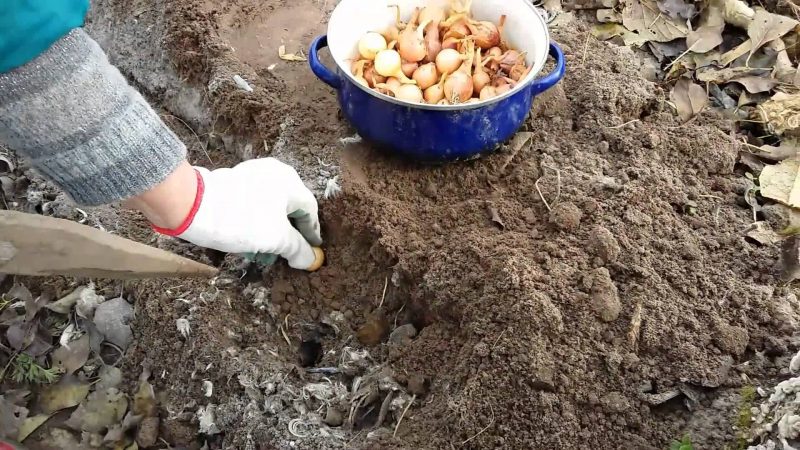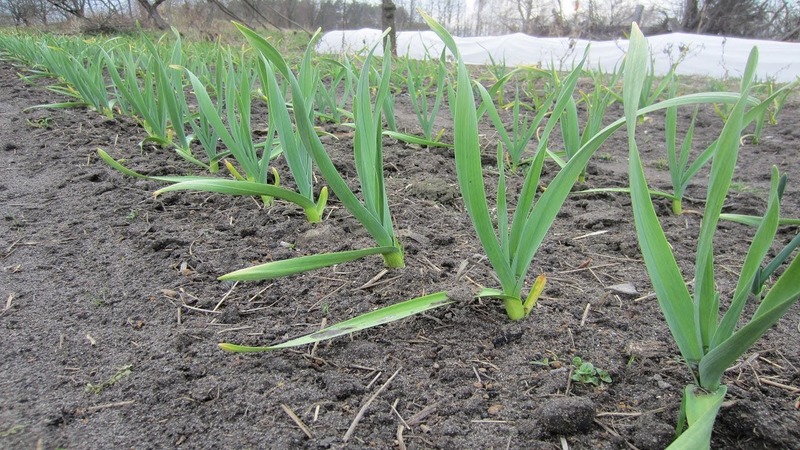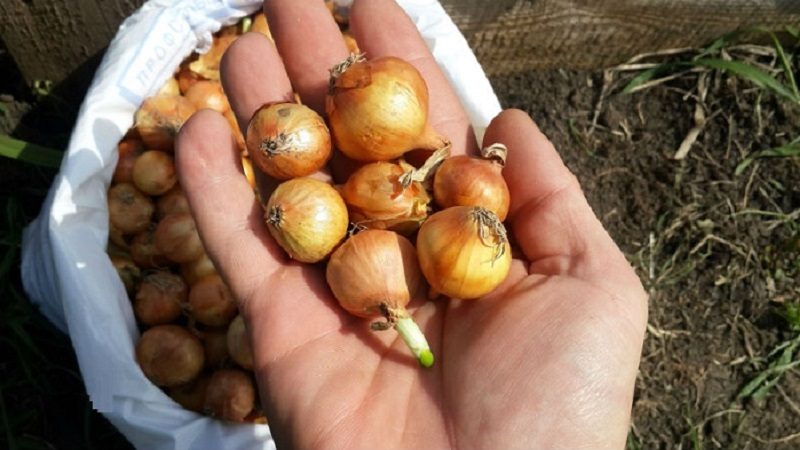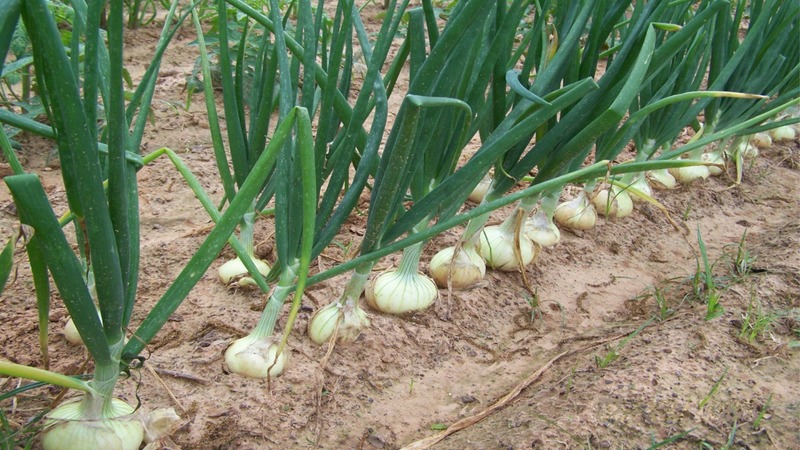How to be and what to do if winter onions have sprung up in the fall
Onions are a useful product containing a large amount of vitamins and substances that inhibit the spread of infection in the body. Even more useful is a vegetable grown with one's own hands without the use of harmful chemicals, therefore, almost every vegetable garden has this crop. But many gardeners are asking questions: when is it better to plant a vegetable in order to get a good harvest, and what to do if an onion planted before winter has sprouted? We will talk about this.
The content of the article
Is it possible to plant sprouted onions before winter

It all depends on how much the onion has sprouted. The options are:
- If the bulb has sprouted a little, it can be to plant before winter with everyone else. Just before that, you need to look at the weather forecast - whether frost is expected the next day. Otherwise, the sprouts may die.
- If the sprouts are medium in size, cut them off and then plant the onions. But such a bow will not give a turnip.
- If the bulb has sprouted strongly, it remains only to throw it away, because there will be no harvest from it.
It is recommended to plant cut shoots in a separate part of the garden bed. So after sprouting, it will be easier to understand where the onion is on the greens (for quick use).
Reference. In order not to throw out the sprouted sevok, it can be planted at home in a jar. Then there will always be fresh herbs to the table.
Advantages and disadvantages of planting onions in the fall
To decide whether to plant onions before winter, you need to weigh the pros and cons.
Planting onions in the fall is a good idea because:
- The harvest will appear early. The bulbs will be larger, no matter which grade planted.
- After harvesting, space will be freed up for planting something new. For small plots of land, this is a suitable solution.
- Onions planted in autumn do not need to be weeded often - weeds do not grow well in cold weather.
- The plant suffers much less from onion flies.
- The winter crop is well stored for a long time.
Disadvantages of planting onions before winter:
- More needs to be planted as not all bulbs will survive the winter.
- Unpredictable weather. If there is little snow and severe frosts in winter, all planted onions will freeze. We'll have to insulate the beds.
Lack of ventilation, high humidity and the presence of mulching material that provides a greenhouse effect in warm weather can lead to the formation of rot. You can determine it visually: it appears as a whitish powdery bloom, the bulb becomes slippery, soft.
Planting spoiled seedlings is fraught with the loss of the entire crop, as the fungus quickly spreads through moist soil and transfers to healthy bulbs.

Important! To prevent the sevok from dying, sprinkle the bed on top with wood sawdust 1-3 cm. In the spring, they will disperse in the soil and create a loosening effect. In this case, the beds can be watered 2 times less often.
When to plant onions for the winter
It is recommended to plant for the winter from late August to late October. This is a long time frame. Much depends on the region of residence. Planting is carried out 3-4 weeks before persistent frost appears.
If the air temperature does not rise above + 5 ° C for 3-5 days, then it is time to plant winter onions.Even a few days of warm weather can provoke growth, so you need to focus on the average daily air temperature.
Landing technology
The method of planting onions for the winter is not particularly difficult. You need to decide on the location of the beds, prepare the soil and seeds.
Site selection and soil preparation
For growing, choose a place that is well ventilated and illuminated by the sun. The area should be open so that as much snow as possible falls on it.
The soil must be loose. You won't be able to grow a lot of onions on clay.
Soil preparation includes:
- weed cleaning;
- digging the beds;
- soil pH check (should be about 6.0-6.2);
- tillage with ash.
Preparing, sorting and processing bulbs before planting

Initially, the bulbs are pickedto remove the sick and not accidentally add to the healthy. Then distribute them by size. A large set is not suitable, choose a size of up to 15 mm.
Important! 14 days before planting, the seedlings are soaked in warm, almost hot water (about 47 ° C), kept for 3-4 hours and removed from the water. If left for a few days, the set will become unusable. landing.
After warming up, they proceed to pickling from potential pests. Apply the drug "Fitosporin M" and its analogues. Soaking for an hour in a solution of potassium permanganate helps.
Landing scheme
Onions for the winter should not be planted too deep. They dig out beds with a depth of 6-7 cm. First, cover them with sand - this way you can save the crop from waterlogging. Planted to a depth of 3-4 cm.
The bulb is placed vertically, pressed by hand and covered with earth from above. The distance between the onions should be at least 7 cm. It is also not worth planting on the same bed more than 10 cm from each other - the space must be spent sparingly. The distance between the beds is at least 15 cm.
What to do if winter onions have sprung up in autumn
After planting in the fall, onions should not emerge earlier than spring. If this happened, you need to understand the reasons and take measures to save the harvest.

Why did it happen
The main mistakes of gardeners that lead to the sprouting of winter onions:
- Planting too early. Despite the fact that many sources recommend starting planting at the end of August - September, one must take into account the peculiarities of the local climate. Premature germination can occur if planted in warm weather in September.
- The planted bulbs are too large. A 2-3 cm sevok will germinate faster than a small one, so you cannot plant it for the winter.
- Wrong drop-off location - humid or too warm, where there is not enough ventilation.
There are also reasons that do not depend on the human factor - for example, late start of winter, abnormally warm autumn.
Will it make sense
If the onions sown before the winter began to germinate ahead of time, it can only be useful in one case - if the winter is mild and warm.
If he still survives, the harvest will be half of the planned, because it will be much more difficult for such onions to germinate further.
At what temperature does the onion germinate before winter
Onions begin to sprout before winter at above-zero temperatures. If the thermometer rises above 12-15 ° C, you should beware of early shoots.
What to do in such a situation
In this situation, the most important thing is to prevent the sprouted onions from freezing.... This will require simple insulation methods. For example, dig out loose earth from the greenhouse, which has not yet frozen, and cover the bed with a layer of 2-3 cm.
In such a situation, mulching material is suitable: cut grass or weeds, compost, fallen leaves, hay, nettles, bark or chips. Mulch is poured on top of the ground. Then the bulbs will be protected from freezing.
If the onions are planted in late August or early September, and there is still time for warm weather, it is worth digging up what has sprouted and sowing the beds with new sevka.However, if the ground is frozen and solid, nothing can be planted in such soil until spring, because the bulbs will not take root.
Care features
Winter onion care is as follows:
- In early spring, the soil is low in nutrients, especially nitrogen. For feeding, it is better to use complex compounds containing nitrogen. Processed at the rate of 30 g per 1 m2 of garden area. Fertilizers are dissolved in warm water.
- In the spring and summer period, they feed at least 1-2 times a month. To do this, take 2-3 kg of herbs and insist in 10 liters of water for 2-3 days. The infusion is filtered, water is added and the onion is poured.
Winter onions do not require specific care. It is resistant to pests. Intensive wateringrequired at the beginning of growth, replace melt water.
Important! In the spring, it is necessary to regularly weed the beds and loosen the soil.
How to protect the garden from frost
To prevent the bed from freezing in winter, use mulching material. Peat, hay, spruce branches, fallen leaves are well suited for winter onions. Any of the materials, 10-14 days after disembarkation, fall asleep in the garden. The colder the region, the thicker the mulch layer is made.
From above, the mulching material is strengthened with branches. It is impossible to cover the beds with foil - this will create too high a temperature and excessive humidity. With the beginning of spring, the insulation material is removed.
Tips & Tricks
You can get a large and high-quality crop by following the following recommendations:
- Treat the soil from weeds, saturate with fertilizers containing nitrogen.
- 2-3 weeks before planting, add ash to the ground - 0.5 kg per 1 m2.
- Go through the sets, checking for damage and signs of rot.
- On the day of planting, first soak the seed for 30 minutes in salt water, then rinse and immerse in a saturated solution of dark pink potassium permanganate for 10-15 minutes.
- After winter, make sure that the soil is always moist.
- When 70% of the onion has risen, begin to loosen the ground at least 1 time per week.
Conclusion
Planting onions in the fall is beneficial and convenient, since the load in the garden decreases at this time of the year. If suddenly winter onions have sprouted ahead of time, you should not despair - this is a solvable problem. Sowing planted and prepared in the right place is the key to success in obtaining a good harvest.